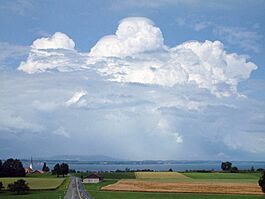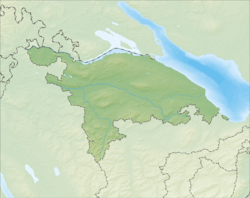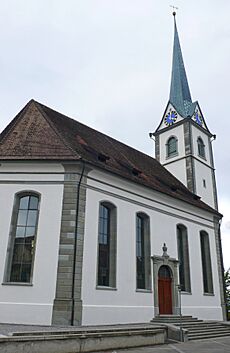Altnau facts for kids
Quick facts for kids
Altnau
|
|||
|---|---|---|---|
|
Municipality
|
|||
 |
|||
|
|||
| Country | Switzerland | ||
| Canton | Thurgau | ||
| District | Kreuzlingen | ||
| Area
Lua error in Module:Wd at line 1575: attempt to index field 'wikibase' (a nil value).
|
|||
| • Total | Lua error in Module:Wd at line 1,575: attempt to index field 'wikibase' (a nil value). km2 (Formatting error: invalid input when rounding sq mi) | ||
| Elevation | 471 m (1,545 ft) | ||
| Population
(2018-12-31)Lua error in Module:Wd at line 1575: attempt to index field 'wikibase' (a nil value).
|
|||
| • Total | Lua error in Module:Wd at line 1,575: attempt to index field 'wikibase' (a nil value). | ||
| Time zone | UTC+01:00 (Central European Time) | ||
| • Summer (DST) | UTC+02:00 (Central European Summer Time) | ||
| Postal code(s) |
8595
|
||
| SFOS number | Lua error in Module:Wd at line 1575: attempt to index field 'wikibase' (a nil value). | ||
| Surrounded by | Güttingen, Hagnau am Bodensee (DE-BW), Langrickenbach, Münsterlingen, Stetten (DE-BW) | ||
| Website | SFSO statistics |
||
Altnau is a small town, also called a municipality, located in the Kreuzlingen area of the canton of Thurgau in Switzerland. It's a lovely place with a rich history and beautiful natural surroundings.
Contents
History of Altnau
Altnau has a long and interesting past! Near a small village called Ruderbaum, people have found signs of an ancient settlement from the Horgen culture. This was a group of people who lived here a very long time ago. There might even be an older settlement from the Pfyn culture underneath it, but experts aren't completely sure yet.
The modern village of Altnau was first mentioned in records around the year 787, called Althinouva. Back in the 700s, a powerful monastery called the Abbey of St. Gall owned most of the land in Altnau. Later, in 1155, a famous ruler named Emperor Friedrich Barbarossa confirmed that the main church in Constance (a nearby city) owned the church and its land in Altnau.
Over the years, different noble families controlled the rights to the church's farms. From 1471 until 1798, the city of Constance itself managed these farms. In 1454, the people of Altnau tried to join a group called the Appenzell Landrecht, which was like a local government. But Constance didn't like that, so Altnau had to leave. The rules for the village were first written down in a document called the Gerichtsoffnung in 1468.
The local church in Altnau was managed by the cathedral in Constance. After the Protestant Reformation in 1528, when many people changed their religion, the church in Altnau became a "shared church" (called a Simultaneum). This meant both Catholics and Protestants used the same building for their services. This continued until 1810, when two separate churches were finally built.
For a long time, until the 1800s, most people in Altnau worked in farming, growing crops in a system where fields were rotated. Around 1880, a dairy company started in the village, and raising animals and making cheese became important. Growing grapes for wine (called Viticulture) was also common from the Middle Ages until 1912.
New roads and railways were built in the 1800s, like the Seestrasse (Lake Road) in 1840 and the Seetalbahn (railroad line) in 1870. However, these new transport links didn't immediately make the local economy boom, partly because the train station was a bit far from the village.
Geography of Altnau
Altnau covers an area of about 6.68 square kilometers (about 2.58 square miles). A large part of this land, about 70.7%, is used for farming. Forests cover about 15.4% of the area, and 13.9% is used for buildings and roads. A small amount, 0.3%, is made up of rivers or lakes.
The town is located in the Kreuzlingen district, close to Lake Constance. It sits along the road that connects Romanshorn and Kreuzlingen.
Population of Altnau
Altnau has a population of about 2,000 people. Around 15.5% of the people living here are from other countries. Over the last 10 years, the number of people living in Altnau has grown by about 11.8%.
Most people in Altnau (about 94.5%) speak German. Other languages spoken include Albanian (1.1%) and Italian (0.9%).
In 2008, there were slightly more men (51.2%) than women (48.8%) living in Altnau. The population is made up of both Swiss citizens and people from other countries.
Here's a look at how Altnau's population has changed over time:
| year | population |
|---|---|
| 1850 | 869 |
| 1910 | 1,001 |
| 1970 | 957 |
| 1980 | 1,036 |
| 1990 | 1,439 |
| 2000 | 1,804 |
Sights in Altnau
The entire village of Altnau is considered a special place and is part of the Inventory of Swiss Heritage Sites. This means it has important historical and cultural value that is protected.
Economy of Altnau
In 2007, Altnau had a low unemployment rate of 1.46%, meaning most people who wanted jobs had them.
The economy of Altnau is divided into three main parts:
- Primary sector: This involves jobs that use natural resources, like farming. About 100 people work in this area in Altnau.
- Secondary sector: This includes jobs that make things, like in factories or construction. About 187 people work in this sector.
- Tertiary sector: This covers jobs that provide services, like shops, schools, or healthcare. About 317 people work in this sector.
Many people who live in Altnau travel outside the municipality for work. In 2000, about 48.2% of residents worked in other towns. However, some people also travel into Altnau for work. Most people use a private car (49.1%) to get to work, while some use public transportation (9.9%).
Religion in Altnau
According to a census in 2000, about 31.6% of the people in Altnau were Roman Catholic, and 48.8% belonged to the Swiss Reformed Church. There are also smaller numbers of people who follow other Christian churches, the Islamic faith, or no religion at all.
Transport in Altnau
Altnau is located on the Lake Line, which is a railway line connecting Schaffhausen and Rorschach. The town has its own train station, Altnau railway station, which is part of the St. Gallen S-Bahn network. This makes it easy for people to travel to and from Altnau by train.
Education in Altnau
Education is important in Altnau. About 79.2% of adults (aged 25-64) have completed either a non-mandatory upper secondary education (like vocational training) or even higher education, such as going to a university or a Fachhochschule (a type of professional university).
Altnau has its own primary school district and a secondary school district. In the 2008/2009 school year, there were 176 students in primary school. This included 44 children in kindergarten. The primary school has both lower and upper levels.
For secondary school, students are grouped based on their academic performance. In 2008/2009, there were 273 students in secondary school. The average class size for all secondary classes was about 18 students.
See also
 In Spanish: Altnau para niños
In Spanish: Altnau para niños







